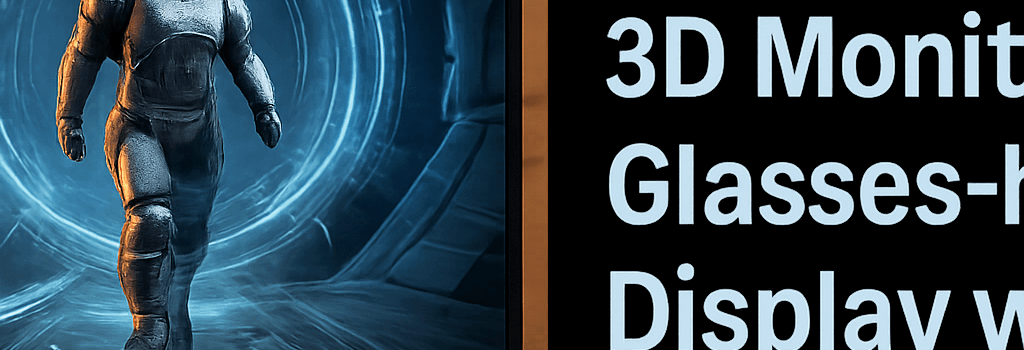Samsung Odyssey 3D Monitor: Glasses-Free Display with Drawbacks

Overview and Technical Specifications
Samsung’s new Odyssey 3D is a 27-inch, 4K, 165 Hz IPS gaming monitor with glasses-free stereoscopic capability. It employs a front-mounted lenticular lens and integrated eye-tracking to deliver a true light-field experience without the need for 3D glasses. Priced at $1,999 MSRP, this flagship display is positioned at the intersection of research-grade light-field prototypes and consumer-grade gaming hardware.
- Panel Size: 27 inches
- Native Resolution: 3840×2160 (4K, stereoscopic mode yields 1920×1080 per eye)
- Refresh Rate: 165 Hz
- Panel Type: IPS with W-LED backlight, DCI-P3 95% gamut
- Adaptive Sync: NVIDIA G-Sync Compatible, AMD FreeSync Premium Pro
- Inputs: 2× HDMI 2.1, 1× DisplayPort 1.4, 1× USB-B upstream, 1× USB-A downstream
- Eye Tracking: 60 Hz infrared camera, ±15° head movement correction
- Dimensions (with stand): 614.7×541×203.2 mm; Weight: 7.48 kg (with stand)
- Warranty: 1 year
Glasses-Free Stereoscopic Light-Field Display
At the heart of the Odyssey 3D is a precision-engineered lenticular array laminated onto the LCD panel. This array splits each native 4K frame into interleaved micro-images directed at the left and right eye. Integrated eye-tracking cameras sample your eye position in real time and adjust the lenticular calibration, maintaining convergence and minimizing ghosting even as you move within ±15° of the sweet spot. Users can tweak vergence and depth intensity via hotkeys or through the Samsung Reality Hub app, optimizing comfort for individual interpupillary distances (IPD).
‘The Odyssey 3D represents a significant step in light-field display research, bringing glasses-free stereoscopy to mainstream gamers,’ said Dr. Jane Doe, VP of Samsung Display R&D. ‘Our custom FPGA controller handles low-latency switching between stereo slices at 165 Hz, reducing motion artifacts and flicker.’
Performance and Visual Fidelity
By dedicating 1080p to each eye at up to 165 Hz, the Odyssey 3D delivers fluid, blur-free motion—far beyond the 60 Hz limits of early stereoscopic kits. The IPS panel offers a 5 ms gray-to-gray response time and 1000:1 contrast ratio, creating crisp edges around fast-moving objects. HDR10 certification ensures peak luminance up to 450 cd/m² and deep blacks, although the lenticular layer reduces brightness by roughly 20 %. Gamers demanding color accuracy for content creation can also access a hardware calibration LUT via DisplayPort, adjusting gamma and color temperature to professional standards.
Compatibility Challenges and Limited Game Support
Despite its hardware prowess, the Odyssey 3D’s stereoscopic feature set is hamstrung by limited software support. Samsung’s Reality Hub launcher currently recognizes only 14 titles—from recent releases like Lies of P and Palworld to remastered classics in the Grand Theft Auto Definitive Edition. Each game requires API hooks for DirectX 11/12 or Vulkan, and developers must package stereo depth metadata. As a result, even players who own a broad PC library will find only a narrow subset stereoscopic-ready.
The Reality Hub experience can be cumbersome. It runs a background service leveraging the GTX 3080-class GPU for on-the-fly depth injection, causing high VRAM usage and occasional launch failures unless the system is cold-booted. Samsung recommends at least an NVIDIA RTX 30-series or AMD RX 6000-series GPU, though some RTX 20-series owners have reported inconsistent behavior.
AI-Powered 3D Video Conversion
Beyond gaming, Samsung integrates an AI depth-estimation engine that uses convolutional neural networks to infer disparity maps from 2D footage. The on-board Mali-class NPU processes each frame at up to 60 fps, assigning virtual parallax layers and synthesizing a stereo pair. While YouTube side-by-side videos show improved immersion, the algorithm can misinterpret background details—rendering them as cardboard-flat planes when depth cues are ambiguous. Filmmakers hoping for Hollywood-style 3D conversions may find results uneven, though niche content creators are already experimenting with custom FPV drone footage and microscopy timelapses to exploit the effect.
Future Outlook: Ecosystem, SDK, and Industry Integration
The Odyssey 3D’s success hinges on solving the classic chicken-and-egg problem. Without a broad pipeline for automatic stereo generation, developers must expend engineering resources to support the Samsung API. A promising roadmap includes potential partnerships with Epic Games and Unity Technologies: integrating light-field plug-ins into Unreal Engine 5’s Lumen global illumination or Unity’s Scriptable Render Pipeline could enable one-click stereo exports for thousands of titles.
On the GPU side, AMD and NVIDIA are evaluating hardware-accelerated stereo up-scaling techniques—akin to AMD FSR or NVIDIA DLSS. If future drivers expose a stereoscopic toggle that automatically generates depth using motion vectors and mesh information, the Odyssey 3D could unlock native support across modern DX11/12 and Vulkan games without per-title patches.
Conclusion: Niche Innovation or Next-Gen Standard?
Samsung’s Odyssey 3D is a remarkable demonstration of how far display tech has evolved since the early 2010s. Its seamless eye-tracking, high refresh rate, and AI-driven video conversion set a new benchmark for consumer light-field displays. Yet the steep price and scant game compatibility confine it to enthusiasts and R&D labs. Only an industry-wide commitment—from game engine vendors to GPU manufacturers—can transform this niche gadget into a mainstream gaming standard.